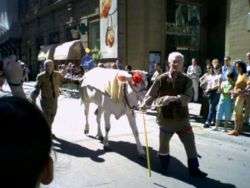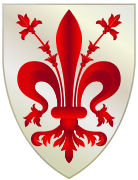Calcio Fiorentino

Calcio fiorentino (also known as calcio storico "historic football") is an early form of football that originated in 16th-century Italy. Once widely played, the sport is thought to have originated in the Piazza Santa Croce in Florence. Here it became known as the giuoco del calcio fiorentino ("Florentine kick game") or simply calcio; which is now also the name for association football in the Italian language. The game may have started as a revival of the Roman sport of harpastum.
Renaissance era
Calcio was reserved for rich aristocrats who played every night between Epiphany and Lent.[1] Even popes, such as Clement VII, Leo XI and Urban VIII were known to play the sport in Vatican City. The games were known to get violent as teams vied with each other to score goals. This game was probably played already in the 15th century, so much that some matches were organized on a completely frozen-over Arno river in 1490. In a historically famous occasion, the city of Florence held a match on February 17, 1530, in defiance of the imperial troops sent by Charles V, as the city was under siege. In 1574 Henry III of France attended a game of "bridge fighting" – put on in his honor during a visit to Venice; the king is recorded as saying: "Too small to be a real war and too cruel to be a game".[2]
The official rules of calcio were published for the first time in 1580 by Giovanni de' Bardi, a Florentine count.[1][3] The game is played on a field of sand with a narrow slit constituting the goal, running the width of each end. Each team comprises 27 players who are allowed to use both feet and hands to pass and control the ball. Goals (or cacce) are scored by throwing the ball over into the netting at the end of the field. There is a main referee, six linesmen and a field master. Each match is played out for 50 minutes with the winner being the team with the most goals scored.


Modern revival
Interest in Calcio waned in the early 17th century. However, in 1930 it was reorganized as a game in Kingdom of Italy,[1] under Mussolini. Today, three matches are played each year in Piazza Santa Croce in Florence in the 3rd week of June. A team from each quartiere of the city is represented:
- Santa Croce / Azzurri (Blues)
- Santa Maria Novella / Rossi (Reds)
- Santo Spirito / Bianchi (Whites)
- San Giovanni / Verdi (Greens)
After playing each other in two opening games, the two overall winners go into the final which occurs each year on June 24; this is San Giovanni (St. John)'s Day, the Patron Saint of Florence. The modern version of calcio allows tactics such as head-butting, punching, elbowing, and choking but sucker punches and kicks to the head are banned.[1] It is also prohibited for more than one player to attack an opponent. Any violation leads to being thrown out of the game.
Rules
Matches last 50 minutes and are played on a field covered in sand, twice as long as it is wide ( approximately 80x40 meters ). A white line divides the field into two identical squares, and a goal net runs the width of each end. Each team has 27 players and no substitutions are allowed for injured or expelled players. The teams are made up of four Datori indietro (goalkeepers), 3 Datori innanzi (fullbacks), 5 Sconciatori (halfbacks), 15 Innanzi o Corridori (forwards). The Captain and Standard Bearer's tent sits at the center of the goal net. They do not actively participate in the game, but can organize their teams and sometimes act as referees, mainly to calm down their players or to stop fights.
The referee and his six linesmen referee the match in collaboration with the Judge Commissioner, who remains off the field. The referee, above everyone else, is the Master of the Field. He makes sure the games runs smoothly, stepping into the field only to maintain discipline and reestablish order in case of a fight on the field.
The game starts when the Pallaio throws and kicks the ball towards the center line, then at the first whistle and at first the ball rests on field, 15 forwards or Corridori begin fighting in a wild mixed martial arts match- punching, kicking, tripping, hacking, tackling, and wrestling with each other in an effort designed to tire opponents' defenses, but which often descends into an all-out brawl, trying to put, pin down, force to submit as many players possible; once there are enough incapacitated players, the other teammates come and swoop up the ball and head to the goal. Then followed by a small cannon firing; the shot announces the beginning of the contest.
From this moment on, the players try by any means necessary to get the ball into the opponents' goal also called caccia. The teams change sides with every caccia or goal scored. It's important to shoot with precision, because every time a player throws or kicks the ball above the net, the opposing team is awarded with half a caccia. The game ends after 50 minutes and the team which scored the most cacce wins.
The prize is also interesting, because along with the Palio, the winning team used to receive a Chianina, a type of cow. However, the prize has been reduced to a free dinner for the winning team; the players earn no other compensation.[4]
In popular culture
The comic book series Bitch Planet includes an event titled "Duemila" or "Megaton"; in issue #4 the event is described: "Megaton is one of many modern descendants of Calcio Fiorentino, a 16th century Italian sport... Teams may have any number of players, but their combined weight can be no more than 2000 lbs!"[5]
In the 2015 film The Tourist, Brett Dalton plays a former college football star who travels to Italy and becomes involved in playing Calcio Fiorentino.
See also
- Volata
- Football in Italy
- Rugby union in Italy
- Takanakuy, fighting festival in Peru
References
- 1 2 3 4 Halpern, J. Balls and Blood, Sports Illustrated. Vol 109, No. 4: August 4, 2008, p. 42.
- ↑ "A Point of View: Sporting spectacle on the piazza". BBC NEWS. 12 July 2013.
- ↑ Bardi, Cosimo. Discorso sopra il giuoco del calcio fiorentino del Puro Accademico Alterato. In Firenze : nella Stamperia de' Giunti, 1580
- ↑ Borden, Sam (2015-07-01). "A Most Dangerous Game". New York Times. Retrieved 2015-07-01.
- ↑ DeConnick, Kelly Sue; De Landro, Valentine (April 2015). Bitch Planet (Issue 4 ed.). Berkeley: Image Comics, Inc. pp. 14–15.
External links
| Wikimedia Commons has media related to Calcio in Costume. |
- http://www.expertfootball.com/history/ History of Soccer from ExpertFootball.com
- https://www.youtube.com/watch?v=WsRqSNSjy3E Video: Calcio Storico Fiorentino Mini-Documentary
- https://www.youtube.com/watch?v=lrCUu8jAYV0 Video: GEO Reportage "Florenz, Fussball bis aufs Blut" (German)
- http://www.puredesign.it/gallery2/main.php/v/calciostorico/ Photogallery: parade and match on 24 June 2008 (Italian)
- https://vimeo.com/25813529
Coordinates: 43°46′08″N 11°15′42″E / 43.76880°N 11.26160°E
